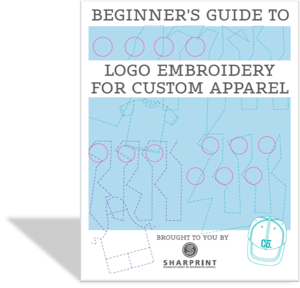Caps, bags, polos, luggage, beach towels!! Yes. We embroider all of these things and more. Small runs. Large runs. Small lettering. Large applique. Bring it on! We'll make you proud.
Embroidery: The Process
Art Requirements
Embroidery Terms
How Fabric Type Affects Design
Along with the many details for processing an order, there are a number of steps that happen between print request and the packing of the finished screen printed product.
When reviewing the art, we look for fine detail, gradients and small lettering that may not translate well. We’ll be sure to make a recommendation or give you some options if your logo will not embroider well on a particular garment.
Digitizing is the process by which we translate digital art files into stitches. The first part of the process is a virtual drawing that maps the stitches we will use to embroider the final logo. This is done using specialized software.
Although the digitized file gives us a pretty realistic assessment of what the final embroidery will look like, we prefer to create an actual stitched out sample to be sure. We’ll make any tweaks or adjustments from there and send the final sew out to you for your blessing.
An embroidery hoop is a plastic ring that snaps around the area of the garment to be sewn. This hoop is affixed to a head on the embroidery machine. This is called clamping. These steps are taken to stabilize the garment as the needle sews the fabric.
Our highest capacity embroidery machine has 15 heads. Many times orders are larger than 15 pieces. A production run for embroidery is called running the lines because we produce the order in a line of 15 at a time.
Once the garments are sewn, we remove the excess backing from the embroidered design. Sometimes a tear-away backing is used, and it can be pulled off. Other times the backing must be cut, or trimmed, from the back of the garment. This step in the process is referred to as trimming no matter which method is used.
The embroidery hoop has a tendency to leave a ring on certain garments. This does not damage the fabric. We simply steam these items to return them to their pre-embroidered appearance.
Embroidered garments are generally more expensive than regular t-shirts. For this reason, we carefully fold and bag each embroidered item to protect the garment from potential damage in shipping.
All art files are re-drawn as digital stitch files in preparation for embroidery. The best embroidery comes from very clean, high quality digital files. Vector format is preferred.
Process for converting digital images or logos into a map of stitches. The digitized file is uploaded to the embroidery machine to provide instructions for location of stitches and thread color.
Stiff fabric applied to the inside of the garment to keep the embroidery stitches stable through embroidery, wear, and wash. There are 3 types of backing:
Tear Away Backing - Tear away is the most common type of backing used. It is the quickest and easiest to remove for the most common types of embroidered garments ordered by our customer. Tear away backing is used on the sturdy, strong fabrics such as caps, dress shirts, back packs etc.
Cut Away Backing - Cut away is used on softer materials that we embroider. This type of backing eliminates the tendency of a fabric to pull away from the embroidered logo when using tear away. We use cut away backing on knit fabrics such as pique.
Fabric Backing - This backing is used only when requested as there is an additional cost. Cut away and tear away backings are sometimes a little visible on light colored garments or very thin material. Fabric backing is silky, super light and barely visible on even the most fragile materials.
Solvy is used to create a smooth foundation for embroidering custom designs. It is applied on the top or outside of the garment and is covered by the embroidered design. Not all garments require the use of a topping. Solvy is primarily used on high pile fabrics (fleece, hoodies, towels) to help the stitches stay visible and avoid the embroidered design becoming lost in the fabric.

With the recent technology advances in the apparel industry, it's important to understand the advantages and limitations of embroidery. This guide will provide you and your customers with a strong foundation in:
